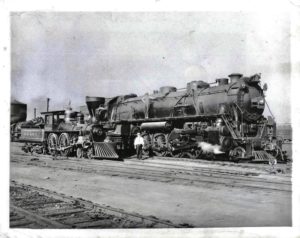We often talk about our train tunnel and if you have been to visit our museum, you probably have seen our infamous tunnel. But did you know, there are actually two Chetoogeta Mountain tunnels in Tunnel Hill, Georgia? The first one was built between July 1848 and October 1849, with the first trains passing through the tunnel on May 9th, 1850. The second tunnel was built in the late 1920’s to replace the original. An old plaque indicates that construction of the second tunnel started in July of 1927 and was completed on December 17th, 1928. Other records list the start date as late 1926. The “new” tunnel was built by the construction department of the Nashville, Chattanooga & St. Louis Railway Company, a lessee of the Western & Atlantic Railroad.

The Tunnels side by side.
As was all too common throughout the South, the Western & Atlantic and Nashville & Chattanooga suffered tremendously during the war. By 1864, both were under Federal control and rebuilt to serve the Union. After the conflict they were returned to private ownership. Almost immediately the Nashville & Chattanooga was again expanding, leasing the Nashville & Northwestern Railroad in August of 1868.
On May 30, 1873 a series of notable corporate changes occurred; on that day the N&NW became the Nashville, Memphis & St. Louis Railway while the N&C was renamed the Nashville, Chattanooga & St. Louis Railway (NC & St. L). This was to be known as the “Dixie Line”. While the Dixie Line never reached St. Louis it did continue expanding while becoming both a successful bridge line and important component of the Louisville & Nashville.

Official 1919 system map of the Nashville, Chattanooga & St. Louis Railroad Line.
In 1890, the Nashville, Chattanooga & St. Louis Railway had leased the track of the Western & Atlantic and begun making improvements on the rails and track. By the early 1900’s, rail traffic had increased in volume on this now important rail route. Also, by this time locomotives and railroad cars had become much larger. The original tunnel proved too small for the larger locomotives and rolling stock of the 20th century.
Train cars were damaging the old tunnel and even becoming stuck. Some train engineers were nearly killed when their locomotive become lodged in the tunnel. Passengers are unloaded from a passenger train to avoid their being overcome by smoke while the stuck train is removed from the tunnel.

A pair of Nashville, Chattanooga & St. Louis F7A’s have a mixed freight at Dalton, Georgia circa 1957. Clarence Cade photo.
The NC & St. Louis Railway looked at enlarging the 1850 tunnel or even blasting a gap in the mountain, removing the “roof top” of the old tunnel. By the 1920’s, this line was part of a major railroad link connecting Chicago and the Midwest with the Atlantic coast for both freight and passenger service. Costs involved and the long disruption in important rail service during changes to the old tunnel led to the decision to build a completely new and larger tunnel.

The General next to a 1915 locomotive engine. You can easily tell the difference.
Upon completion on December 17th 1928, all train movements were transferred to the new tunnel. The 1850 tunnel was abandoned after 78 years of service. The 1928 tunnel is still in use today by CSX Railroad. This photo speaks volumes, showing the famous locomotive “The General” parked next to a much larger 1915 locomotive.




